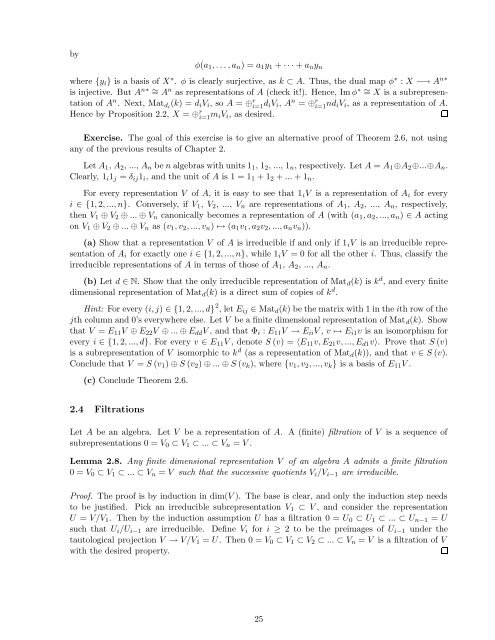Lecture notes for Introduction to Representation Theory
Lecture notes for Introduction to Representation Theory
Lecture notes for Introduction to Representation Theory
You also want an ePaper? Increase the reach of your titles
YUMPU automatically turns print PDFs into web optimized ePapers that Google loves.
y<br />
θ(a 1 , . . . , a n ) = a 1 y 1 + · · · + a n y n<br />
where {y i } is a basis of X ⊕ . θ is clearly surjective, as k → A. Thus, the dual map θ ⊕ : X −⊃ A n⊕<br />
is injective. But A n⊕ ∪ = A<br />
n<br />
as representations of A (check it!). Hence, Im θ ⊕ ∪ = X is a subrepresentation<br />
of A n . Next, Mat di (k) = d i V i , so A = r i=1 d iV i , A n = r i=1 nd iV i , as a representation of A.<br />
Hence by Proposition 2.2, X = r i=1 m i V i , as desired.<br />
Exercise. The goal of this exercise is <strong>to</strong> give an alternative proof of Theorem 2.6, not using<br />
any of the previous results of Chapter 2.<br />
Let A 1 , A 2 , ..., A n be n algebras with units 1 1 , 1 2 , ..., 1 n , respectively. Let A = A 1 A 2 ...A n .<br />
Clearly, 1 i 1 j = ζ ij 1 i , and the unit of A is 1 = 1 1 + 1 2 + ... + 1 n .<br />
For every representation V of A, it is easy <strong>to</strong> see that 1 i V is a representation of A i <strong>for</strong> every<br />
i {1, 2, ..., n}. Conversely, if V 1 , V 2 , ..., V n are representations of A 1 , A 2 , ..., A n , respectively,<br />
then V 1 V 2 ... V n canonically becomes a representation of A (with (a 1 , a 2 , ..., a n ) A acting<br />
on V 1 V 2 ... V n as (v 1 , v 2 , ..., v n ) ⊃ (a 1 v 1 , a 2 v 2 , ..., a n v n )).<br />
(a) Show that a representation V of A is irreducible if and only if 1 i V is an irreducible representation<br />
of A i <strong>for</strong> exactly one i {1, 2, ..., n}, while 1 i V = 0 <strong>for</strong> all the other i. Thus, classify the<br />
irreducible representations of A in terms of those of A 1 , A 2 , ..., A n .<br />
(b) Let d N. Show that the only irreducible representation of Mat d (k) is k d , and every finite<br />
dimensional representation of Mat d (k) is a direct sum of copies of k d .<br />
Hint: For every (i, j) {1, 2, ..., d} 2 , let E ij Mat d (k) be the matrix with 1 in the ith row of the<br />
jth column and 0’s everywhere else. Let V be a finite dimensional representation of Mat d (k). Show<br />
that V = E 11 V E 22 V ... E dd V , and that i : E 11 V ⊃ E ii V , v ⊃ E i1 v is an isomorphism <strong>for</strong><br />
every i {1, 2, ..., d}. For every v E 11 V , denote S (v) = ◦E 11 v, E 21 v, ..., E d1 v. Prove that S (v)<br />
is a subrepresentation of V isomorphic <strong>to</strong> k d (as a representation of Mat d (k)), and that v S (v).<br />
Conclude that V = S (v 1 ) S (v 2 ) ... S (v k ), where {v 1 , v 2 , ..., v k } is a basis of E 11 V .<br />
(c) Conclude Theorem 2.6.<br />
2.4 Filtrations<br />
Let A be an algebra. Let V be a representation of A. A (finite) filtration of V is a sequence of<br />
subrepresentations 0 = V 0 → V 1 → ... → V n = V .<br />
Lemma 2.8. Any finite dimensional representation V of an algebra A admits a finite filtration<br />
0 = V 0 → V 1 → ... → V n = V such that the successive quotients V i /V i−1 are irreducible.<br />
Proof. The proof is by induction in dim(V ). The base is clear, and only the induction step needs<br />
<strong>to</strong> be justified. Pick an irreducible subrepresentation V 1 → V , and consider the representation<br />
U = V/V 1 . Then by the induction assumption U has a filtration 0 = U 0 → U 1 → ... → U n−1 = U<br />
such that U i /U i−1 are irreducible. Define V i <strong>for</strong> i ⊂ 2 <strong>to</strong> be the preimages of U i−1 under the<br />
tau<strong>to</strong>logical projection V ⊃ V/V 1 = U. Then 0 = V 0 → V 1 → V 2 → ... → V n = V is a filtration of V<br />
with the desired property.<br />
25

















